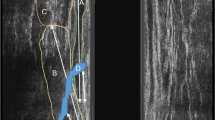PURPOSE: The aim of this study was to assess the morphologic change of the anal canal in patients with rectal prolapse. METHODS: The endoanal ultrasound scans of 18 patients with rectal prolapse were compared with those of 23 asymptomatic controls. The thickness and area of the internal anal sphincter and submucosa were measured at three levels. RESULTS: Qualitatively, patients with rectal prolapse showed a characteristic elliptical morphology in the anal canal with anterior/posterior submucosal distortion accounting for most of the change. Quantitatively, internal anal sphincter (IAS) and submucosa (SM) thicknesses and area were greater in all quadrants of the anal canal (especially upper) in patients with rectal prolapse compared with controls. There was statistical evidence (in a regression model) of a relationship between increases in all measured variables and the finding of rectal prolapse. CONCLUSIONS: The cause of sphincter distortion in rectal prolapse is unknown but may be a response to increased mechanical stress placed on the sphincter from the prolapse or an abnormal response by the sphincter complex to the prolapse. Patients found to have this feature on endoanal ultrasound should undergo clinical examination and defecography to look for rectal wall abnormalities.
Similar content being viewed by others
Author information
Authors and Affiliations
Corresponding author
About this article
Cite this article
Dvorkin, L., Chan, C., Knowles, C. et al. Anal Sphincter Morphology in Patients With Full-Thickness Rectal Prolapse. Dis Colon Rect 47, 198–203 (2004). https://doi.org/10.1007/s10350-003-0035-4
Issue Date:
DOI: https://doi.org/10.1007/s10350-003-0035-4




